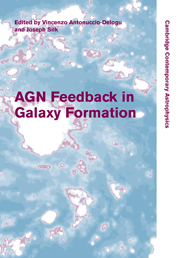Book contents
- Frontmatter
- Contents
- List of contributors
- Preface
- The organising committees
- Part I AGNs, starbursts and galaxy evolution
- 1 The effects of mass and star-formation timescale on galaxy evolution
- 2 Suppressing cluster cooling flows by multiple AGN activity
- 3 Starburst and AGN activity in Spitzer-selected sources at high-z
- 4 Star formation in galaxies hosting active galactic nuclei up to z ∼ 1
- Part II Co-evolution of black holes and galaxies
- Part III Outflows and radio galaxies
- Part IV Models and numerical simulations: methods and results
- Index
1 - The effects of mass and star-formation timescale on galaxy evolution
from Part I - AGNs, starbursts and galaxy evolution
Published online by Cambridge University Press: 10 November 2010
- Frontmatter
- Contents
- List of contributors
- Preface
- The organising committees
- Part I AGNs, starbursts and galaxy evolution
- 1 The effects of mass and star-formation timescale on galaxy evolution
- 2 Suppressing cluster cooling flows by multiple AGN activity
- 3 Starburst and AGN activity in Spitzer-selected sources at high-z
- 4 Star formation in galaxies hosting active galactic nuclei up to z ∼ 1
- Part II Co-evolution of black holes and galaxies
- Part III Outflows and radio galaxies
- Part IV Models and numerical simulations: methods and results
- Index
Summary
Introduction
In a ∧CDM cosmology, the growth of structure occurs hierarchically; small objects form first and undergomergers to form more massive objects. Modelling the formation and evolution of galaxies with numerical simulations is impossible because crucial aspects lack a complete physical model – notably, feedback and star formation.
An alternative to full numerical simulations is the semi-analytic models (Croton et al. 2006; De Lucia et al. 2006), so called because they use approximate prescriptions for physical processes that are poorly understood. These prescriptions contain parameters that are set by demanding that the model reproduces the observations of (typically) low-redshift galaxies. The process itself is often motivated by a result from a more detailed numerical simulation or from observations.
The cooling of gas is central to the process of galaxy formation, as it sets the rate at which gas becomes available for star formation. Feedback processes have the largest impact on the predictions for galaxy properties, as these processes affect the efficiency of galaxy formation by increasing the cooling time of hot gas and suppressing further star formation. Previous iterations of the semi-analytic models (Kauffmann 1996), which lacked a prescription for feedback, predicted that the galaxy population should continue to evolve at z < 1, at a rate greater than that due to passive evolution, as more massive galaxies are built up by continued mergers.
- Type
- Chapter
- Information
- AGN Feedback in Galaxy Formation , pp. 3 - 10Publisher: Cambridge University PressPrint publication year: 2010

